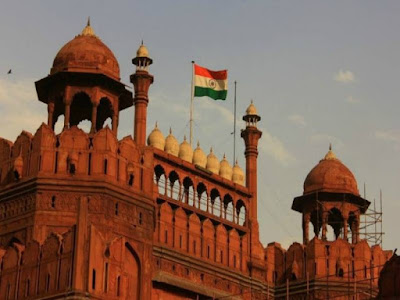The Harmandir Sahib and the Darbar Sahib located in the city of Amritsar, Punjab (India) are informally known as the Golden Temple. Built in the 16th Century by Guru Arjan Dev, the golden Temple opens from four gates which symbolises the openness of Sikhism towards all the people and all the religions.
Jasa Singh Ahluwalia with the help of other Sikh Misl’s re- builded the present- day Gurudwara in 1764 with the intention of building a place of worship for all the men and women irrespective of their cast or social status. Guru Granth Sahib, the most holy text of Sikhism is always present inside the Golden Temple.
The temple welcomes more than one lakh worshippers on a daily basis. As the name states, the Golden Temple is made up of pure gold thus attracting lakhs of tourists from all around the world. The reflection of the Golden Temple in the pond located in the premises of the Gurudwara under the moonlight acts as one of the major attractions for the tourists.
The Sufi saint Main Mir laid the foundation of the Golden Temple with the intention of building one of the best historical Sikh monument in the world. The Golden Temple is surrounded by a large holy tank or a Sarovar with the presence of a number of holy shrines named after the Sikh Gurus. While entering the Golden Temple, proper code of conduct is to be maintained by the visitors. The code of conduct is based on the following principles:
I. It is essential to maintain the purity of the sacred temple and one’s own body while entering the premises.
II. It is essential to open the shoes while entering the temple premises and washing feet in a small pool of water provided.
III. Smoking cigarettes, eating meat, drinking alcohol is not permitted inside the temple premises.
IV. As a sign of respect, it is essential to cover one’s own head with a piece of cloth. Visitors without a cloth are provided one while entering the temple.
V. It is also essential to sit on the ground in order to show respect to Shri Guru Granth Sahib and God.
Viasakhi is celebrated in the second week of April at all the Gurudwars including Sri Harmandir Sahib or the Golden Temple. The day of Vaisakhi is considered to be a sacred day by the Sikhs because it is believed that Khalsa was founded on that day.
A number of other celebrations such as the birthday of Guru Nanak Dev, the martyrdom day of Guru Tej Bahadur are celebrated on a large scale at the Golden Temple. The Golden Temple is lit up with Diya’s beautifully on the occasion of Diwali and special fireworks and lightening are also visible on the day. Most of the Sikhs visit Sri Harmandir Sahib at least once in their lifetime.
Jasa Singh Ahluwalia with the help of other Sikh Misl’s re- builded the present- day Gurudwara in 1764 with the intention of building a place of worship for all the men and women irrespective of their cast or social status. Guru Granth Sahib, the most holy text of Sikhism is always present inside the Golden Temple.
The temple welcomes more than one lakh worshippers on a daily basis. As the name states, the Golden Temple is made up of pure gold thus attracting lakhs of tourists from all around the world. The reflection of the Golden Temple in the pond located in the premises of the Gurudwara under the moonlight acts as one of the major attractions for the tourists.
The Sufi saint Main Mir laid the foundation of the Golden Temple with the intention of building one of the best historical Sikh monument in the world. The Golden Temple is surrounded by a large holy tank or a Sarovar with the presence of a number of holy shrines named after the Sikh Gurus. While entering the Golden Temple, proper code of conduct is to be maintained by the visitors. The code of conduct is based on the following principles:
I. It is essential to maintain the purity of the sacred temple and one’s own body while entering the premises.
II. It is essential to open the shoes while entering the temple premises and washing feet in a small pool of water provided.
III. Smoking cigarettes, eating meat, drinking alcohol is not permitted inside the temple premises.
IV. As a sign of respect, it is essential to cover one’s own head with a piece of cloth. Visitors without a cloth are provided one while entering the temple.
V. It is also essential to sit on the ground in order to show respect to Shri Guru Granth Sahib and God.
Viasakhi is celebrated in the second week of April at all the Gurudwars including Sri Harmandir Sahib or the Golden Temple. The day of Vaisakhi is considered to be a sacred day by the Sikhs because it is believed that Khalsa was founded on that day.
A number of other celebrations such as the birthday of Guru Nanak Dev, the martyrdom day of Guru Tej Bahadur are celebrated on a large scale at the Golden Temple. The Golden Temple is lit up with Diya’s beautifully on the occasion of Diwali and special fireworks and lightening are also visible on the day. Most of the Sikhs visit Sri Harmandir Sahib at least once in their lifetime.


